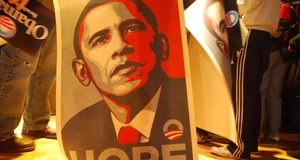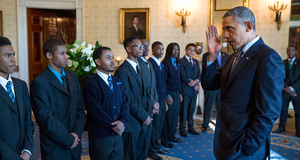From Elon Journal of Undergraduate Research in Communications VOL. 4 NO. 1Truth and Context in the 2012 Presidential DebatesIV. Debate and Media AnalysisDebate 1: October 3, 2012 The first debate took place at the University of Denver in Denver, Colorado. It was moderated by Jim Lehrer of PBS’s NewsHour and was intended to consist of six individual segments on domestic policy. Instead, the segments merged into one and Lehrer struggled to get a word in edgewise, let alone challenge any af-firmation made by either candidate. FactCheck.Org, a project by the Annenberg Public Policy Center at the University of Pennsylvania, said both candidates uttered “exaggerations and false claims” in their first meeting.14 Much of the first de-bate was focused on the economy, or the candidates managed to bring the thread of conversation back to the economy. In even his opening statement, Barack Obama began with facts on the economy, stating that five million jobs had been added to the private sector in the past 30 months.15 While that fact may be true as stated by preliminary revisions of a report from the Bureau of Labor Statistics, it is the first example of a statement removed from context, in this case, historical perspective. In the recovery from the 2001 downturn, during George W. Bush’s presidency, five million jobs were added in the 30 months following the lowest point of that economic slump, just like the recovery from 2008. The two economic downturns before 2001, however, saw faster recovery than did the ’01 and ’08 events, making both Bush and Obama’s numbers off historic pace.16 Obama then told an outright lie about Republican candidate Mitt Romney’s tax plan, which he said called for a $5 trillion tax cut.17 While Romney has proposed cutting numerous taxes and extending the Bush tax cuts, the nonpartisan Tax Policy Center estimated this would only result in a $480 billion cut in the year 2015. The figure Obama gave was an extrapolation of the cut over ten years, not just in one. Romney also said he wanted to broaden the tax base, which could make up for that lost revenue. 18 The use of this extrapo-lation is an ideal example of the use of context as manipulation. By using this much larger sum of $5 trillion, Obama sought to paint Romney as an irresponsible budgeter and someone who would greatly increase the country’s deficit. On the other side of the stage, Romney told an outright lie when he said Obama had doubled the deficit during his time in office. This is not true. The fiscal year of 2009 actually began in October 2008, when Bush was still president. The Congressional Budget Office had already estimated that the deficit for 2009 would top $1.2 billion, before Obama was even elected or took office. To the uneducated observer, it would appear that the dates indicate the deficit’s increase took place under Obama’s tenure, but in fact, it hardly did at all.19 Romney also repeated a false claim that he said several times throughout the campaign. He said Obama’s health care law cuts $716 billion from Medicare. This is unsubstantiated. The health care law cuts payments to health care providers and insurers; it doesn’t take funds from Medicare recipients. USA TODAY’s fact checking team pointed out another curious point about that false statement: Romney’s vice-presidential candidate actually did propose a $716 billion cut to Medicare recipients in his 2012 budget proposal. By using this false $716 billion figure as an attack without mentioning that his running mate proposed a real cut of the same magnitude indicates Romney was relying on the average viewer and voter to be unfamiliar with Wash-ington politics and will latch on to the “Obama will de-fund healthcare for senior citizens” concept, something that is untrue.20 The candidates exchanged various other jabs throughout the night, on energy, health care and sev-eral other elements of the economy including tax cuts for the wealthy, a main point of contention throughout the campaign. Polling by both CNN and CBS right after the conclusion of the debate showed that the majority of debate-watchers thought Romney “won,” by a nearly 3-to-1 margin in CNN’s study21 and 2-to-1 margin in CBS’s.22 Debate 2: October 16, 2012 Nearly two full weeks after the first debate, CNN’s Candy Crowley moderated the second in Hemp-stead, New York, at Hofstra University. This one was “town hall style,” quite different from the first as it was attended by a group of undecided voters, all of whom had come up with their own questions to ask of Obama and Romney. Crowley and her team selected the questions, which the voters themselves asked. Crowley provided some, but not much, direction beyond that. This debate was also much different than the ones that came before or after because the candidates were allowed to stand while giving responses, and move about the small stage, creating a far more hostile air. It was also in the second debate that Romney offered a third category to the truth and context classifi - cation: reversals of previous statements. Romney offered up several statements that could be declared lies if held up against previous assertions. Like the first debate, many of the challengeable statements made by both candidates came back to the economy, or some facet of it. In the first question posed by one of the audience members, Romney stated that he wanted to keep the nation’s federal Pell Grant program “growing.” 23 Previously, Romney had called the program “unsustainable.” His running mate, Paul Ryan, again, had called for massive cuts to the program.24 Romney had a similar reversal of opinion when he stated he wouldn’t cut taxes for the wealthy. What Romney probably meant was that he wouldn’t cut taxes for “just” the wealthy, since he called for cuts for all. Romney also gave incorrect facts about the number of women who had lost their jobs since Obama took office (it’s only 93,000 as factored by the Bureau of Labor Statistics, not Romney’s stated 580,000).25 Obama had a similar number of fact gaffes, mostly when discussing his opponent’s position on issues like immigration and new energy. He incorrectly stated that Romney called Arizona’s immigration law a “mod-el” for the nation and that Romney said jobs in the wind industry were “imaginary.”26 In both cases, Obama was manipulating quotes made by Romney on those topics. He had indeed called a part of Arizona’s immigra-tion law a “model,” but just a part.27 Romney had also not called jobs in wind energy “imaginary,” but had said Obama had a vision of an “imaginary world where government-subsidized windmills and solar panels could power the economy.”28 But the largest fact-check of the night occurred on stage when Obama publicly challenged a state-ment made by Romney and was then backed up by moderator Crowley, resulting in audible applause from the audience, something that was not supposed to happen. Romney thought he was catching the president in a lie, challenging him about his debate statement that he called the attacks on the American embassy in Benghazi, Libya an “act of terror,” the day after the event in a speech in the Rose Garden of the White House. “I want to make sure we get that for the record, because it took the president 14 days before he called the attack in Benghazi an act of terror,” Romney said, to which Obama replied, “Get the transcript.” 29 The overall nature of the debate was more offensive as opposed to defensive than the first. Both can-didates seemed to be on the attack. There was a reversal in the polling numbers on which candidate “won,” although there was a far narrower margin between the two. In both the CNN30 and CBS News31 post-debate poll, Obama beat Romney by seven points. Debate 3: October 22, 2012 Just six days after the Hofstra debate, Bob Schieffer of CBS’s Face the Nation, moderated the final de-bate at Lynn University in Boca Raton, Florida. Although it was divided into six segments like the first debate, this one was on the topic of foreign policy, although it sometimes veered off track. This was also the first debate in which one of the candidates (Obama) got truly catty and seemed to be stepping outside of the bounds of respectful debate discourse. The first occurrence happened when Romney said the United States Navy had less active ships than any time since 1917. This is a lie. According to the Naval History and Heritage Command, the number of active duty ships hit at all-time low since the 19th century in 2007 under Bush’s second term, when just 278 vessels were active. There are now 285 active ves-sels (2011 figure).32 But in response to this claim, Obama retorted: Well, Governor, we also have fewer horses and bayonets, because the nature of our military’s changed. We have these things called aircraft carriers, where planes land on them. We have these ships that go underwater, nuclear submarines. And so the question is not a game of Battleship, where we’re counting slips. It’s what are our capabilities.33 Obama also had a sarcastic comment about statements Romney made on Russia several months before the debates. Throughout the debate, most of Obama’s misrepresentations were about Romney’s positions, not just on foreign policy, but also on education and health care, despite the intended focus of the debate. A verbal al-tercation about Romney’s position on bailing out the American auto industry occurred as Obama said Romney didn’t support giving funds to these companies.34 Romney insisted that he did not support letting the auto industry go bankrupt, but his own words are in direct contrast to that fact. In a November 18, 2008 op-ed piece in the New York Times titled “Let Detroit Go Bankrupt,” Romney said “If General Motors, Ford and Chrysler get the bailout that their chief executives asked for yesterday, you can kiss the American automotive industry goodbye.”35 However, it is clear that Romney supported federal loan guarantees for car companies.36 On education, Romney restated a fact he commonly brought up throughout the campaign that stu-dents in Massachusetts were very highly ranked during his governorship. While this is true, these rankings were just as high before Romney took office and remained there after he left the governorship, an impor-tant point of context he left out.37 Obama also had a dramatic out-of-context fact, saying that unemployment among veterans of the United States military is lower than that of the general population. While this may be true, Obama neglected to mention that this doesn’t include veterans of wars started since 2003, Iraq and Afghanistan. They actually have an unemployment rate that is higher than that of the general population and peaked at 15.2 percent during Obama’s first term.38 The third and final debate had the most on-stage fact checking between the two candidates of all three matchups, and the margins of victory were even wider than the second debate. The CBS post-debate poll showed that Obama “won” the debate 2 to 1.39 The CNN poll was narrower, with just an eight-point lead for Obama over Romney.40Continued on Next Page » Suggested Reading from Inquiries Journal
Inquiries Journal provides undergraduate and graduate students around the world a platform for the wide dissemination of academic work over a range of core disciplines. Representing the work of students from hundreds of institutions around the globe, Inquiries Journal's large database of academic articles is completely free. Learn more | Blog | Submit Latest in Business & Communications |



















